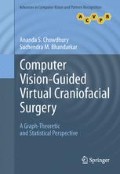Abstract
In this chapter, we propose an alternative technique for detection and localization of mandibular fractures using the concepts underlying network flow. As mentioned previously, the fractures mandibular could be either (a) hairline or minor, denoting situations where the broken bone fragments are not visibly out of alignment or have incurred very little relative displacement, or (b) major, denoting situations where the broken fragments are clearly displaced relative to each other. In the previous chapter, we modeled a minor or hairline fracture as a stochastic degradation of a hypothetical intact mandible. Here, we model a fracture as a discontinuity or cut in the flow of intensities between two designated points, termed as the source and sink in a directed graph or flow network. A fracture is detected by determining a minimum cut in the flow network using the well-known Maximum-Flow Minimum-Cut (Max-Flow Min-Cut) algorithm by Ford and Fulkerson. This approach for identification and localization of fractures is shown to yield more promising results in the case of minor fractures while requiring very little preprocessing of the input image data. We first model a sequence of 2D CT image slices as a collection of independent 2D directed graphs and execute the max-flow min-cut algorithm on each such directed graph. Later, we model the sequence of 2D CT image slices containing a fractured mandible as one complete 3D directed graph and run the same max-flow min-cut algorithm on it. The max-flow min-cut algorithm is shown to be successful for both 2D flow network and 3D flow network representations. The flow network is constructed based on the knowledge of the geometry of the human mandible and the fracture pattern. Although, simple capacity functions are designed as edge weights in the flow network representation, the network flow-based scheme is shown to be effective in the detection of minor fractures.
Access this chapter
Tax calculation will be finalised at checkout
Purchases are for personal use only
References
Ogundare BO, Bonnick A, Bayley N (2003) Pattern of mandibular fractures in an urban major trauma center. J Oral Maxillofac Surg 61(6):713–718
Cormen TH, Leiserson CE, Rivest RL, Stein C (2001) Introduction to algorithms. MIT Press, Cambridge
Ford LR Jr, Fulkerson DR (1962) Flows in networks. Princeton University Press, Princeton
Giannoudis PV, Dinopoulos H (2005) Current concepts of the inflammatory response after major trauma: an update. Injury 36(1):229–230
Boykov Y, Veksler O, Zabih R (2001) Fast approximate energy minimization via graph cuts. IEEE Trans Pattern Anal Mach Intell 23(11):1222–1239
Boykov Y, Jolly MP (2001) Interactive graph cuts for optimal boundary & region segmentation of objects in N-D images. In: Proc IEEE int conf on computer vision (ICCV), Vancouver, Canada, pp 105–112
Xu N, Bansal R, Ahuja N (2003) Object segmentation using graph cuts based active contours. In: Proc IEEE int conf on computer vision pattern recognition (CVPR), Madison, WI, USA, pp 46–53
Freedman D, Zhang T (2005) Interactive graph cut based segmentation with shape priors. In: Proc IEEE int conf on computer vision pattern recognition (CVPR), San Diego, CA, USA, pp 755–762
Funka-Lea G, Boykov Y, Florin C, Jolly MP, Moreau-Gobard R, Ramaraj R, Rinck D (2006) Automatic heart isolation for CT coronary visualization using graph-cuts. In: Proc IEEE int symp on biomedical imaging, Arlington, VA, USA, pp 614–617
Song Z, Tustison N, Avants B, Gee J (2006) Adaptive graph cuts with tissue priors for brain MRI segmentation. In: Proc IEEE int symp on biomedical imaging (ISBI), Arlington, VA, USA, pp 762–765
Boykov Y, Jolly MP (2006) Graph cuts and efficient N-D image segmentation. Int J Comput Vis 70(2):109–131
Boykov Y, Kolmogorov V (2004) Fast approximate energy minimization via graph cuts. IEEE Trans Pattern Anal Mach Intell 26(9):1124–1137
Author information
Authors and Affiliations
Corresponding author
Rights and permissions
Copyright information
© 2011 Springer-Verlag London Limited
About this chapter
Cite this chapter
Chowdhury, A.S., Bhandarkar, S.M. (2011). Fracture Detection Using Max-Flow Min-Cut. In: Computer Vision-Guided Virtual Craniofacial Surgery. Advances in Computer Vision and Pattern Recognition. Springer, London. https://doi.org/10.1007/978-0-85729-296-4_8
Download citation
DOI: https://doi.org/10.1007/978-0-85729-296-4_8
Publisher Name: Springer, London
Print ISBN: 978-0-85729-295-7
Online ISBN: 978-0-85729-296-4
eBook Packages: Computer ScienceComputer Science (R0)

